|
FAQs about the Clownfishes & Anemones,
Hosts 9
Related FAQs: Clownfish/Anemones 1, Clownfish/Anemones 3, Clownfish/Anemones 3, Clownfish/Hosts 4, Clownfish/Hosts 5, Clownfish/Hosts 6, Clownfish/Hosts 7, Clownfish/Hosts 8, Clownfish/Hosts 10, & Clownfishes in General, Clownfish Identification, Clownfish Selection, Clownfish Compatibility, Clownfish Behavior, Clownfish Systems, Clownfish Feeding, Clownfish Diseases, Brooklynellosis, Breeding Clowns,
Related Articles: Clownfishes, Clownfish
& Anemone Compatibility By James Gasta, Maroon Clowns, Anemones,
|
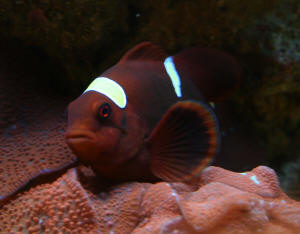
|
Rock Flower Anemone Questions
7/13/10
Hey James.
<Jordan>
I searched your website, and I haven't found anything on what
I'm trying to figure out. So I have a clarkii clownfish that hosts
in a Condy anemone in my 10 gallon reef,
<Too small a tank for that combo.>
and in my 37 gallon I have an ocellaris clownfish pair that are very
aggressive and won't let me add any fish to the tank (new fish are
almost always dead the next day from the clownfish attacking them).
What I want to know is whether or not there is a chance that if I
switched the clownfish whether or not I could add a rock flower anemone
that the clarkii will host. The clarkii is wild caught.
<Is unlikely that your clarkii would host a rock anemone.>
I also want to know whether or not the lighting I have on the 37 gallon
is enough, it's a FOWLR with 65 watts of
PC (50/50 bulb). I've read in a ton of places saying that my
lighting would be fine if I kept the bulb fresh, but I've also read
that it isn't enough. I'm not sure but any help would be
great.
<Is not enough lighting for any of the anemone species your clarkii
would host. Except for the Bubble Tipped Anemone (BTA), all will
require intense lighting.>
Thanks.
<You're welcome. James (Salty Dog)>
Re Rock Flower Anemone Questions 7/13/10 - 7/14/10
So your <you're> saying that a buble <Bubble> Tip
Anemone would do fine in a 37gal with 65 watts
of PC?
<No, I said that of all the anemones clownfish would host, all but
the BTA would require intense lighting. One 65 watt lamp would be
border line at best for the Bubble Tip Anemone. Twin 10-12K lamps
should provide the light intensity they require.>
I know that most anemones need intense light but I've been told
that Rock Flower Anemones will adapt to very many light intensities and
usually don't need high light at all.
<You are correct, Rock Flower Anemones (Epicystis crucifer) do well
under moderate lighting. My point was that it is unlikely that your
clownfish would host this anemone species.
James (Salty Dog)>
One Clownfish Hosting TWO Anemones/Clownfish
Compatibility 7/12/10
Dear WWM Crew,
<Nick>
I apologize if this has already been addressed in another thread; I
could not locate anything and you all have been so helpful in the past!
I have 4 clownfish - 1 is a Maroon and 3 are False Percula - (they all
get along even though I've been advised against having them in the
same tank, they have lived together for quite some time peacefully) and
I have one Green Bubble Tip Anemone and one Rose BTA, each on opposite
ends of the tank.
My question is rather or not I can do anything to encourage my Perculas
(at least one of them; I'm not sure if more than 1 fish will host
the same anemone?) to host one of the anemones.
<It's not unusual for more than one clownfish of the same specie
to host an anemone.> For now, my Maroon has decided that he needs to
host them BOTH! Lol. Since the Maroon has began hosting them, the other
three clowns have moved into a corner of my tank near one of the
anemones (the one the Maroon most often hosts) and cuddle every night
like a little family.
<The Maroon Clownfish can be aggressive and are very territorial,
and obviously his territory includes both anemones. If it were me, the
Maroon Clownfish would go.>
Other than my Maroon 'hogging' the anemones, my fear is that,
being a more aggressive breed, he will begin to try dominating the
tank, as he is quite protective of "his" anemones and by
hosting two, he will feel he has to protect the entire aquarium.
<Very likely.>
Here is some information about my tank:
75 Gallons (48" long), 3 (only using 2 at the moment) 1050gph
Korella <Koralia> Power Heads, 90 pounds live rock, 80 pounds
live sand, 0 nitrates, 0 nitrites,
<.05ppm phosphates, 490ppm calcium, oxygen is good (according to
test kit; don't know the numbers off hand), 9dkh, Red Sea Venturi
skimmer, 140 gallon sump, UV, carbon filter, undetectable iron.
For livestock, I have about 10 snails, 4-5 hermit crabs with plenty of
empty shells, 1 large feather duster (more sprouting up in the tank
than I can count on my live rock), 1 gobby <goby>, 2 cleaner
shrimp (who go everywhere
together), 1 Blue Chromis (damsel), 1 Yellow Tail (damsel), my clowns,
1 small blue sponge (doing very well) and 1 red sponge (having some
problems).
Since I am writing, and if you don't mind giving further advice, my
red sponge appears to be disintegrating toward the top; the base of the
sponge looks fine, but the upper portion looks like it's white
string instead of red sponge. He has plenty of current IMO (but would
love yours too)
and I make sure that if I ever see sand on him (he is perched on a
rock), I clean him off with a syringe. Should I cut off the
"dead" parts to try to aid in its recovery?
<No, and do read/learn here and linked files in the header.
http://www.wetwebmedia.com/sponges.htm>
Thank you for the valuable advice I know you will offer me!
<You're welcome. James (Salty Dog)>
~Nick
|
Hi Bob,
I have a full stocked soft coral reef tank, it is a 4x2x2 and
everything seems to be doing well. My water parameters are;
Ammonia 0 Nitrite 0 and Nitrate 15 temperature of 26°
and salinity of 1.025ppm.
I have a pair of common clownfish which seem to always swim
around the top of the aquarium, it is quite frustrating for me as
a lot of the time they are not in view and it sometimes seems
pointless having them!
I would like to buy them an anemone as I think this will help
them feel more at home and possibly be more 'active'
members of the tank. Which anemone do you think would be best in
my reef tank? And are there marked differences in aggressiveness
between different species?
Thank you in advance
Thomas Duffel, Bristol
<Thank you for writing so well; that is,
clearly and thoroughly Thomas. I do indeed have strong feelings
re the use of Anemones in our hobby interest and there definitely
are better choices amongst what is available'¦ and
their handling. For general use and for pairing with any species
of Clownfish the best choice is the Bubble-tip Anemone, Entacmaea
quadricolor, in particular, the more and more readily available
asexual clones of this species that arise from individuals
fissioning themselves in captivity. Bubble-tips are the hardiest,
most adaptable species of Actinarians that are naturally
symbiotic with the Damsels we call Clowns'¦ and
happily, on the lower end of likelihood to have 'wars'
with other types of life, especially other stinging-celled life
(e.g. 'corals') that hobbyists keep. This being stated,
there are still some important caveats to list re the appropriate
use of this species'¦ indeed with all Anemones. First
off, they are NOT compatible with other Cnidarians, and will
fight them chemically and physically to a degree under any set of
conditions. Lessening the likelihood of this negative interaction
is your job'¦ To wit: having a larger, less-crowded
set up, that is well-established, stable is important to the
extreme. Placing the anemone well away from other stinging-celled
life (a good twenty cm.) and being on your guard should it move
about is a chief concern as well. Now, a few words that are
rarely discussed concerning a very important technique for
properly 'introducing' new Cnidarian (Coral,
Anemone'¦) life to an established system. It is a VERY
good idea to initially house new acquisitions in a separate
(isolation, quarantine) system'¦ and add water back
and forth twixt these two systems every few days for a few weeks
time, ahead of physically moving all into your main/display. This
water-mixing allows for a goodly amount of 'smelling' of
parties and their getting used to each other gradually, rather
than outright adding them where they can greatly harm each other.
Of course, one wants to wait at least a few days with new
arrivals in isolation to begin this process'¦ to
prevent spread of disease, pests'¦ but scooping,
pouring a few pints of water twixt each goes a long way to
reducing aggressive behaviour initially. Should you find it
difficult to find a cloned Bubble-tip, a wild-collected one is
your second best choice'¦ A third would be a Leather
or Sebae Anemone (Heteractis crispa)'¦ Neither of
these are found in close association with the common Clown
(Amphiprion ocellaris) in the wild, but this relationship is
often formed in captive circumstances. >
|
Artificial Anemone 6/8/10
Dear Crew,
<Carolyn>
In a nutshell, I'm wondering if there are any lifelike artificial
anemones that would make a suitable home for my two pink skunk clowns
(Amphiprion perideraion)? They lived happily in a beautiful Heteractis
crispa anemone for around 12 months before the poor anemone died -
entirely my fault I'm sorry to say, I should have known better
after 10 years of fish keeping than to buy an animal out of pity! The
anemone had suffered bleaching but we managed to nurse it back to life
for a while, however either I didn't feed it sufficiently/correctly
or something wasn't right in the tank for it as it eventually faded
and died.
<You must have done something right to nurse a difficult anemone to
keep back to health and have it survive for a year. Have you ever read
here?
http://www.wetwebmedia.com/marine/inverts/cnidaria/anthozoa/heteraccrispa.htm>
I would love to keep an anemone again, however (partially out of guilt
for previous 'nem) I don't think I can bring myself to do it
out of the knowledge that these amazing creatures out-live humans on
the reef however show such a poor survival rate in captivity.
<They are relatively hardy, problem is the stress/damage they
encounter from the reef to your LFS's display tank.>
The second major reason being that I've since downsized to a 60 US
gallon system from the previous 150 US gallon tank. If size wasn't
an issue I'd go for a captive raised Bubble Tip Anemone, however
although many people keep these is systems even smaller than mine (bear
with me while I get off my soap-box and take a nice, calm breath...
better), I think it's size would be an issue as I intend to keep
sps in the not-too-distant future (once I've finally gotten my
hands on a nice new Deltec MCE600 skimmer.
Gurgle)..
<Not a good idea to mix the two, has been done frequently and I
presently have a BTA with LPS, SPS, and softies. The initial problem
lies when the anemone is first introduced....they rarely will stay
where you put them and
will sting corals and/or sessile invertebrates while moving. I kept a
good vigil on mine until he found a place to his liking and has
remained there since, although a watchful eye is always
present.>
OK, apologies for rambling :D Back to the issue - while the clowns will
be perfectly happy without a host 'nem, I'd still like the look
of having one in the tank without actually risking the life of one of
Gods most amazingly beautiful animals. Any suggestions?!
<May want to get a couple of these artificial anemones. Take a look
here.
http://www.sourcingmap.com/bright-yellow-silicone-sea-anemone-vivid-decor-for-aquarium-tank-p-68612.html>
Many thanks,
<You're welcome. James (Salty Dog)>
Carolyn
|
Clownfish Sores 6/7/10
Good Evening,
<Good morrow to you Adam>
Where to start... I moved a pair of clownfish that I had, had in
my possession for several years into a new 120G tank (with 60G
fuge in the basement, and 40G sump in the basement), after proper
cycling etc. Shortly after moving them in, they started to get
these white sores on the sides of their bodies / fins, which
would eventually slough off exposing the muscle underneath. They
would then heal, and the clowns would get new sores, rinse and
repeat. None of the other fishes were effected.
<Mmm>
A purple tang I also had in my possession started to show signs
of ich, so I took all the fish out of the 120DT and treated them
all with hypo. This was the first time I had tried hypo and
unfortunately I killed all of my fish save a couple which I gave
away because, as far as I can tell, the pH dropped rapidly (less
buffering capacity in hyposaline conditions), hard lesson to
learn.
<Yes... much more than "salts" lost utilizing this
technique
(hyposalinity); carbonate, bicarbonate among others>
Fast forward 3 weeks later, I bought two new clownfish and a
mandarin.
Since I did not have any fish in the tank I did not QT, as I can
get the clowns out if need be. If you are wondering about the
mandarin, the tank is now close to 3/4 of a year old, and there
are plenty of pods for him, he is significantly plumper now than
when I purchased him, and there are still plenty of pods for him
to eat.
Now to the problem. The new clowns I purchased started to show
signs of this ulceration that my old clowns suffered from. There
is no change in their behavior, no change in appetite, no change
in breathing, no signs of disease except they get these nasty
sores. I would have taken them out a while ago and treated them
in QT, however, my research has no been able to come up with what
exactly I am treating. Whatever it is, is not fatal. The sores
seem self limiting, however like I mentioned before, once one
heals usually another starts. Initially there appears to be a
cottony growth, which loosens, and then falls off. If the sore is
on the body, the muscle is exposed, and if it is on a fin, the
whole part of the fin ends up missing.
Does not look like ich, velvet, or brook.
<Agreed>
More details about my tank. It is a 5 foot 120, lit with 3 MH,
two Vortechs, apex controller, dose bulk reef supply 2 part with
Mag, have a Deltec and octo skimmer, all of my parameters are
those to be expected of a successful reef tank. Undetectable
ammonia, nitrite, nitrate and phosphate.
450 Calcium, 9 Alk, temp is 77, salinity is 1.025. Corals are
doing great.
Mandarin is also apparently disease free.
<All good data>
Picture CF1 shows the female with an early sore on her tail. Then
CF2 shows
its progression. CF3 shows the female with an end stage lesion
where it is no longer getting any bigger. CF3 also shows the male
with a lesion at the base of his tail, and then another starting
on his tail.
OCF1 is a picture of one of my old clown fish that had a sore on
his body.
Same type of sores that these are getting.
Thank you for your time,
Adam
<These marks look to be sores... from burns/stings, likely
from the Euphylliids in your photos, kept in the same system.
Either your Clowns will "make peace" with the
Euphyllia, Catalaphyllia present, or perish from them. Mmm, do
read here: http://wetwebmedia.com/clnfshanmf7.htm
and as much of the linked files in the series (above)... Bob
Fenner>
|
 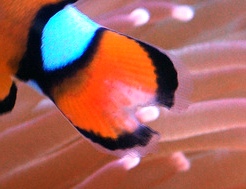 
 |
|
Re: Clownfish Sores 6/7/10
Hi Bob,
<Yo Adam>
Your theory seems quite sound, when my old clowns moved from the
old 60G, to the new 120, they were hosted by a torch as opposed
to the frogspawn that had previously hosted them (torch has a
much stronger/stickier sting).
<Agreed>
The new clowns are hosted by a rather large and mean elegance
(the elegance regularly eats my snails).
<I saw this in your excellent photos>
I do have a bubble tip anemone, however it lives on the other
side of the tank, I do not see the clowns finding it on their
own.
<Perhaps in time>
There is an easy way to test this. I will put the two clowns in
my fuge/frag tank in the basement, which shares the same water
from my display.
The only difference being there is a complete absence of
Euphyllids.
<Ahhh!>
I will get back to you and report if there is any change.
<I thank you>
Thank you for your time. As usually you have been incredibly
helpful.
Adam
<Welcome my friend. BobF>
Re: Clownfish Sores 6/13/10
Well done Bob!
<Medium rare please!>
Already less a week in the fuge and my clown fish are healing
well. No new signs of sores, and all the damage done is repairing
itself.
<Ah good>
Would it be worth while to try the clowns in the elegance for a
while longer? Or shall I just bite the bullet and sell the
elegance?
<It looks like a very nice specimen... How about moving it
(the Catalaphyllia) to your refugium? This species can "get
by" just fine w/ not much light (along with regular
foods/feeding)... or another system entirely?>
Thanks again,
Adam
<Congratulations on your success. BobF>
|
Skunk Clown Has Problems 6/5/10
Hi,
We've had our pink Skunk Clown for several months now. He's
been hosting in a Condylactis anemone
<Mmm, can "work out", but not always... Not native
partners as you know>
and has always been active and "normal". About 2 weeks ago,
he stopped hosting (the first thing we find strange) and now
floats/swims at the top of the tank on his side (weird but normal
swimming behaviours for clowns, I
know). As of yesterday he has developed a bubble on only one of his
eyes and it appears to be red in the center. Any thoughts? advice?
Thanks!
Amy
<Some sort of injury likely... physical most probably... Only time
(not moving, medications) will improve. Perhaps read here:
http://wetwebmedia.com/clndistrauma.htm
Bob Fenner>
Clarkii Clown And LTA 5/16/10
Hello.
<Hello Jennifer>
Hopefully you can help us out. My husband and I recently started a
saltwater aquarium, and love the new hobby. I purchased a Clarkii clown
and a LTA at the local store yesterday. These two were together at the
store and hoped it would be the same at home. The clown has still taken
to the LTA at home, but the LTA hasn't had a chance to foot in the
sand because the clown keeps bothering it. Does it or can it hurt the
LTA if it doesn't foot somewhere? Any suggestions on helping it
foot somewhere safe? Please help...
<Yes, it is best to allow the LTA to get a foothold before
introducing a clownfish. The simplest way is to place an egg crate
plastic divider in the tank separating the two until the LTA settles
in.
The egg crate material is available at Home Depot or similar stores and
can be found in the lighting
department. You may want read/learn about your LTA here.
http://www.wetwebmedia.com/macrodoreensis.htm>
thanks in advance.
<You're welcome. James (Salty Dog)>
|
White growth on percula clown 04/18/10
Hi,
<Morning John>
I'm a big fan of the site, visited many many times over the
years, and I usually can find the information I need by simply
searching through your site. This time I need a little more help
if you can spare it.
<I can>
My percula clown has developed a rounded white growth just above
his gills on the side of his body. I just noticed it a few days
ago. I took some photos on Wed when I noticed it (attached) and
now on Sat (attached), and it has grown quickly. The lesion is
mostly white, with an irregular surface, with some component
under the surface of the scales, grown from about 2 mm 4 days ago
to about 3 mm today, and raised about 2 mm or so.
There may also be a tiny new lesion close to the dorsal fin now
that wasn't there Wed.
He is a few years old, not a recent member of the tank.
<Is the Euphyllia new?>
I have a 45g reef tank with healthy coral and invertebrates, and
my water parameters are good. As far as I know he has not been
injured recently, and his activity level/feeding are normal.
However, he has had a major stressor in his life, since his
beloved years-old anemone disappeared a couple of weeks ago, and
he has taken to hanging out with some hammerhead coral
instead.
<Yes>
Reading through your site and others, I was thinking this could
be viral Lymphocystis (cauliflower disease), or possibly a
parasite, epitheliocystis, or a reaction to injury.
What do you think?
<The last>
He is not in quarantine at the moment. Clearly the treatment,
prognosis, and infectiousness are different depending on the
diagnosis. What would you recommend?
<Mmm, either trying to be patient, removing the Euphyllia or
replacing the lost Anemone>
Thanks in advance,
John V
<Welcome. Bob Fenner>
|
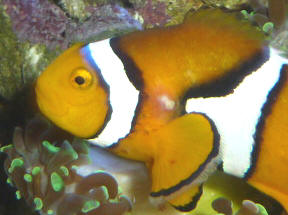 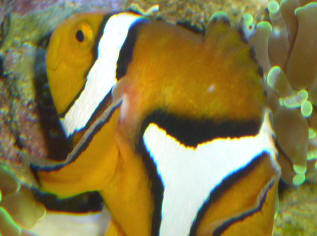
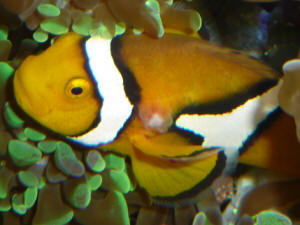 |
|
Re: White growth on percula clown
4/18/2010
Hi Bob,
<Hey John>
Thank you for the quick reply. I really appreciate your opinion.
I am relieved that it probably isn't an infection of some
kind.
<I'm very confident that this injury is resultant from
sting, irritation here>
The Euphyllia has also been in the tank for a few years, and the
clown has previously gone to it many times, when the anemone
would retract for example. I would rather not remove the
Euphyllia since it seems like a good citizen otherwise (and
because I have 5 heads of it). I will try to have some patience
to allow the sore to heal, but it isn't easy. I will look
into getting a new anemone as well.
Thank you for your help,
John
<Welcome. BobF>
|
False Percula Clownfish & Long Tentacle
Anemone/Clownfish/Anemone Compatibility -- 4/4/10
hey crew,
<Hey Caleb>
I have a 29 gal biocube and I recently purchased a False Percula
Clownfish and an Long Tentacle Anemone at Petco, at Petco there was a
Cinnamon Clown already bonded with the anemone but I desired the false
percula instead hoping that it would bond with the anemone instead.
After two days it does not go anywhere near the anemone it just stays
close to the glass and to the surface, should I purchase the Cinnamon
Clown so it can lead by
example?
<Won't work, should the Cinnamon Clownfish host the LTA in your
tank, it will likely drive the percula away from anemone.>
Is there any way I can help the fish to bond ?
<No. If your False Percula Clownfish was tank bred, it is unlikely
that it will host the LTA. Time must also be given for this
relationship to occur/develop. A newly introduced clownfish just
doesn't jump into an anemone. You may want to learn more about your
LTA by reading here and related articles/FAQ's. http://www.wetwebmedia.com/macrodoreensis.htm
>
thanks,
<You're welcome. James (Salty Dog)>
Caleb Boyette
|
Clownfish with welts -- 03/23/10
Good morning.
<G'morrow to you>
I was wondering if it is common for a clownfish to get welts on
it's fins when it first starts to host an anemone or
coral.
<Yes it is>
I know it isn't Cryptocaryon irritans because I have dealt
with that in the past and unlike a sprinkling of pin sized or pin
head sized dots these are more like welts/pimples on the caudal
and pectoral fins and one close to the dorsal.
<Agreed>
I saw these before on another pair of clownfish but only one or
two spots (but in the same areas) that to my knowledge never
hosted my BTA, but who knows what happens when the lights are
out. Since moving those clowns to my frag tank the welts cleared
up. My newer clowns spend all day in the anemone for the most
part but have only been together with the anemone since Saturday
( after 5 weeks of QT with no incident). None of the other fish
(a gramma and a YW goby) have ever had these marks. No excessive
slime, no torn fins, no heavy breathing or other signs of illness
like flashing either. They have voracious appetites as well ( and
even feed the anemone!) I have attached a few pictures. The
pictures of the spot by the dorsal shows its
"pimpleness" more but the spots on her tail are the
same, as well as the few on her pectoral, but harder to get a
clear picture of. Any help would be greatly appreciated.
Keith
<I do think this is likely "getting to know you"
reaction markings... though your last image, showing the
Zoanthids "next door", may indicate a mal-interaction
as well. Bob Fenner>
|
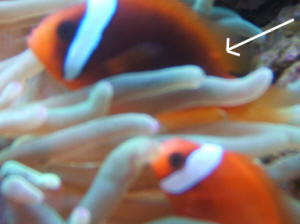 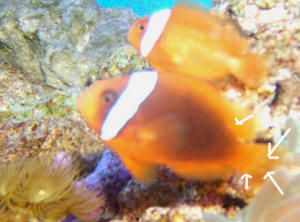 |
Clownfish with welts -- 03/23/10
I forgot to mention from my previous email with the same subject
line, I have seen the same clownfish with the more prominent
welts/ pimples willingly enter my torch coral and give a
"ouch I got stung" reaction...but yet still
occasionally does it anyway when not in the BTA.
<Ahh! Could well be the explanation here. BobF>
Re: clownfish with welts 3/23/10
<I do
think this is likely "getting to know you" reaction
markings... though your last image, showing the Zoanthids
"next door", may indicate a mal-interaction as well.
Bob Fenner>
Mmm yeah. ha ha ha, Needless to say where I initially placed my
BTA and where it decided to be is a far cry east, however it has
stayed there now for several weeks. I will watch for interactions
and possibly frag/move the Zoas. Thanks so much for all your help
I greatly appreciate your time.
Keith
<Certainly welcome. BobF>
|
Is my Clown going to love my Anemone to death? -
01/18/2010
Good afternoon Crew!
<Mornin' Cilla>
Because you all are so comprehensive I am sure the answer is in here
somewhere, but alas, it has eluded me and I trust hardly any source but
my beloved WWM recently. I have been reading through "FAQs on
Anemones and Clownfishes" et all, because I have an overly
attentive clown I fear is doing more harm than good. Let me give you
too much information which I promise I'll try to keep succinct, but
I'll fail at...
<Let's see...>
My husband and I have a 72G bow front we acquired via Craig's List
two years ago which we have added to over the months slowly. Last month
we had 1 Scopus <affectionately named Ting Ting>, 1 six line
wrasse <Sassafras>, 2 tomato clowns <Phil Jr. and Chris
Jr.> and 2 yellow tailed damsels <Maxwell and Agent 99> with
assorted cleaner critters. We were having our floors re-done and our
floor guy was talking about how he had a saltwater tank, which he
hated, and was planning on flushing his inhabitants later that week. Of
course we promptly adopted said mystery fish, which turned out to be
the largest Tomato clown you have ever seen <Big Momma>. For the
time being everyone is playing nice, we will promptly take action if
this changes. Two days ago after some research we decided to add a
Bubble Tip to our soap opera, and he charged around the tank for about
3 hours until he found the perfect spot. About three hours after that
Big Momma discovered the anemone and it was love at first sight. Except
she is too loving I fear. Every time I try to feed the anemone a krill
he starts to close in around it, but Big Momma steps in and pulls it
out in an attempt to "clean house" I think. She also shoves
herself so violently in and round his tentacles I'm afraid she is
doing damage.
<Might>
I realize it's early in their relationship and I do need to let it
play out a little bit more, but at what point in time do I become
concerned?
<When the BTA is apparently damaged, or not opening>
My LFS says "If I were him" I'd remove the Tomatoes and
other Damsels "before I even put them in" because they are
just too mean, but I named them and now I'm attached (silly
females). Or am I just completely over reacting and she is supposed to
do bizarre things like the aforementioned?
<Hard to judge from here>
I hold you all in the highest regards and hope to hear from you
soon!!
Priscilla
<Do keep a "strawberry basket" handy to cover over the
anemone if it isn't opening... or a plastic colander to float the
Tomato otherwise... Bob Fenner>
False Percula hosting Trachyphyllia?
1/6/2010
Good evening all.
<Hello,>
I have been searching your wonderfully awesome site as well as the net
in general for the past three hours, and have not been able to find
much regarding my question. I apologize if the info I'm requesting
has been right at my fingertips and I've missed it. We have had our
125gl all glass tank for a year and thanks to all of you gents and
ladies have had wonderful success. Your site has been an invaluable
resource for us.
<Cool.>
I'm just wondering if it's common for our female False Percula
to be hosting our Trachyphyllia geoffroyi.
<Not uncommon. Clownfish are pretty adaptable, especially tank-bred
specimens that have instincts rather than experience.>
We've had the 2 clowns since the tank was set up and the brain for
about 4 months. I noticed a week or so ago that the female clown was
spending tremendous amounts of time laying in and rubbing the
brain.
<To develop their immunity to the stings, Clownfish will rub
themselves against the host Cnidaria repeatedly, initially only gently
and then more and more seriously. The biology is obscure, but Clownfish
to need to acquire their immunity and aren't born with it.>
The male doesn't venture near it. The brain seems to be in good
health...opening and eating well. Should we have any worries?
<Provided the coral can feed normally and isn't showing signs of
irritation, then no, there are no particular worries. It's not like
you can do anything to dissuade the Clownfish.>
Thanks for all you do...you are all very much appreciated!
Amy
<Cheers, Neale.>
Re Saltwater Aquarium Stocking Questions
12/8/09
Is there any chance that the clownfish might try to nestle into the
mushroom anemones? I've had a clown before and it tried nestling
into hair algae so I'm concerned it might do the same in this
situation and the mushrooms might consume them.
<Is unlikely for a clown to take to mushrooms although they have
been known to host Elegance and similar corals. No danger of the
commonly kept mushrooms (Discosoma and Rhodactis) consuming a clownfish
unless you happen to get a Giant Cup Mushroom (Amplexidiscus spp.) as
these guys are known fish eaters. They can expand somewhere near 12
inches in diameter. James (Salty Dog)>
|
Maroon clownfish hosting mushroom corals
11/3/09
Hello,
Our maroon clownfish has been hosting mushroom corals for a
couple of years.
<Does happen>
She has favorites, but is not particular. My question is whether
the "hosting" results in propagation of the corals.
<Interesting to speculate. It might>
They just keep reproducing--more so than we can handle. If the
maroon is indeed a farmer, I guess we will continue having to
find homes for the mushrooms.
Thank you.
Joan
<And you for sharing. Do trade some of your surplus out. Bob
Fenner>
|
 |
Table of symbiotic relationship is unclear to me.
Clowns... 8/18/09
Could the table at the bottom of
http://www.wetwebmedia.com/marine/inverts/cnidaria/anthozoa/anemones.htm
be clarified to indicate clearly that "X" means it does host
or does not host?
<"X" indicates the species have been found in the wild to
be (naturally) symbiotic>
I am not sure whether the X is good or bad for a particular
pairing.
Thanks
Joe
<Which does not mean that they will for sure automatically associate
in captivity, nor that pairs not found in such relationships in the
wild will not form such bonds in aquarium settings... Read on further
on WWM re:
http://www.wetwebmedia.com/ca/volume_3/cav3i1/Clown_anemone/Clown_anemone.htm
and the linked files at bottom. Bob Fenner>
clownfish/clam/carpet anemone, hosting --
08/14/09
First of all, GREAT SITE!!! I have had my tank going less than 3 months
now and I have spent countless hours reading articles and FAQs.
<Ah, good>
I have a couple of problems and I have searched pretty thoroughly for
answers but I still need some advice.
<"Fire away">
My first problem is that I made a rookie mistake of listening to a
"salesman" at the LFS. I now have a carpet anemone which was
a mistake for several obvious reasons as you know (tank not being
established long enough for starters). My tank is 130 gallon with
closed loop circulation and 145 lbs of live rock, 3 1/2 inch sandbed,
refugium, 2x 250w 14k metal halide lights and everything seems to be
going very well. Since cycling I have yet to have any detectable
nitrate and haven't lost any livestock. I have a sohal tang, powder
brown tang, 5 damsels, coral banded shrimp, peppermint shrimp, 5
hermits, various snails, sand-sifting star and serpent star, Vanuatu
clam and the above mentioned carpet and a maroon clown.
I intend to make this a reef tank. I have no plans to add many more
fish and I may try to trap and give away the damsels. I want to have a
few fish and lots of inverts and corals. I do have a few mushroom
corals that are doing well also although I plan to wait several more
months before adding more corals. So getting to my dilemma. The anemone
seems to be doing well.
With everything I have read he seems to have what he needs and be in an
ideal location. I put him in a corner that gets good light and medium
flow. He was able to put his foot in a rock crevice and he hasn't
moved from where I placed him. I am concerned that one he could eat my
fish.
<Mmm, the Maroon will likely "steer" such fishes away...
Oh, I see it's in the Tridacnid... Well, most fish are well-aware
of anemones...>
2 he can get potentially very big. Theoretically if he is happy where
he is he could stay in the tank just fine and not bother anyone. He is
out of the way and I can place my corals in many other areas. If I
didn't overfeed he could occupy that corner happily for a long time
without getting too big. Is this realistic?
<A possibility>
Too much to hope for? Bottom line, should I remove the anemone and give
him away or take him back to the LFS even if I don't get a refund?
Or should observe and hope?
<I'd likely do the last>
2nd problem. My clown is hosting in the clam instead of the
anemone.
<Happens>
I moved the clam as close as I felt safe to the anemone in hopes the
clown might switch. So far the fish hasn't been mean to the clam
and oddly the clam rarely tries to close up even when the clown really
tries to
nestle in. The clam always reacts when other fish get too close but so
far the clown doesn't seem to bother him. Is there a way to
discourage the clown from trying to host the clam and do I even need to
worry about it?
<Not really on both counts>
I don't want the clown to accidentally kill the clam.
Thanks in advance and sorry for the long question.
Dan
<Glad to share. Bob Fenner>
|
|

